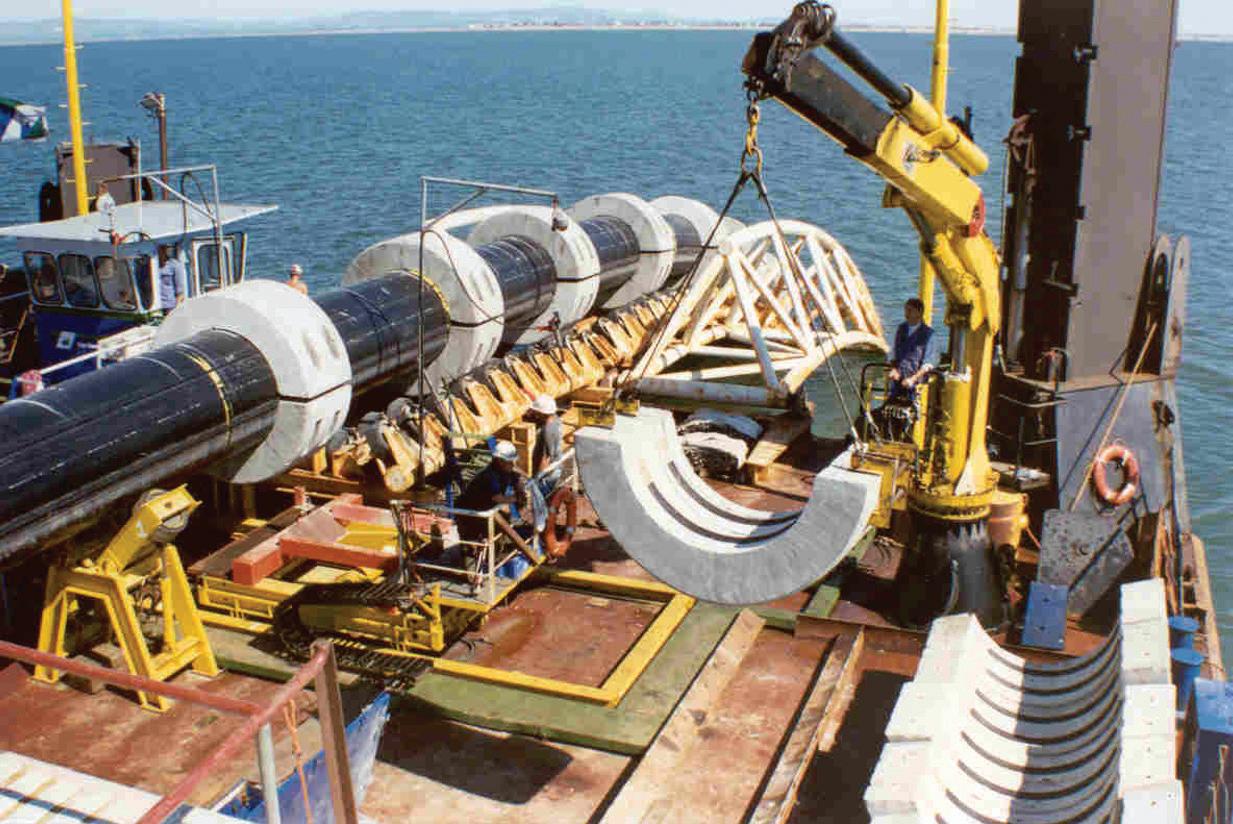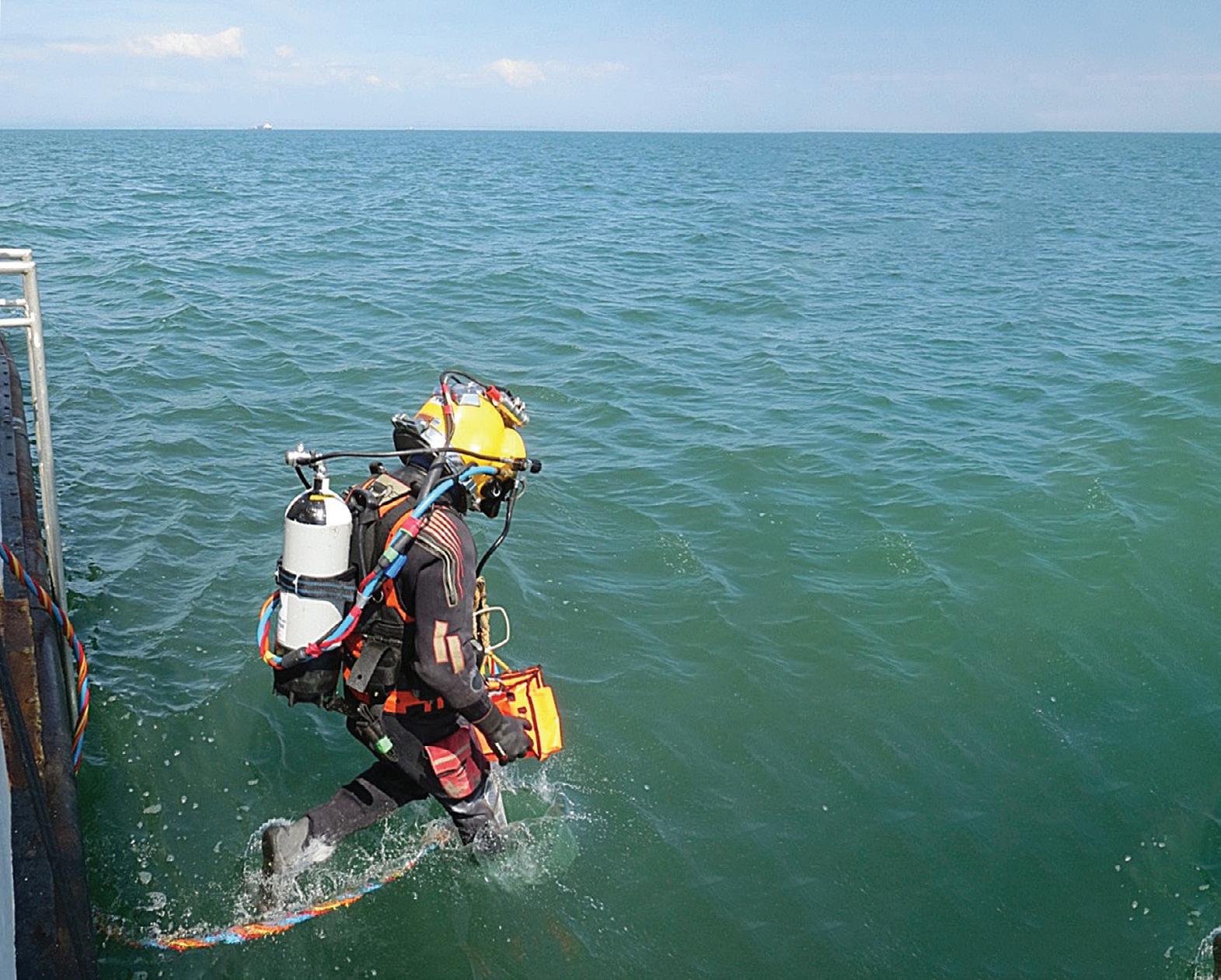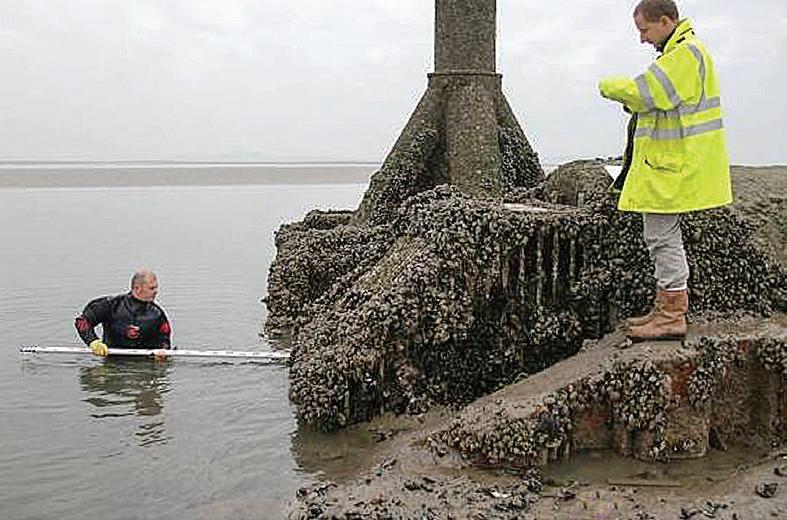
7 minute read
Marine Outfalls the Forgotten Assets
MARINE OUTFALLS The Forgotten Assets Martin Berry details the need for development, maintenance and replacement programmes with these forgotten assets.
We see them along estuaries and at the coast; in harbour walls and even on beaches. In fact they are so familiar as to have become almost invisible, but outfalls, especially marine outfalls, serve an important purpose with which comes significant responsibilities.
MARINE OUTFALLS
A marine outfall’s purpose is described as: ‘a pipeline, tunnel or structure that discharges a wastewater to the marine environment to utilise the assimilative capacity for further treatment’. Outfalls are often associated with water companies, industrial and power facilities and, while they might be quite lengthy, most of the pipes are usually buried so that we are only aware of the physical length of pipe that protrudes into the open and above MHWS (Mean High Water Springs).
WATER AND WASTEWATER
The term ‘water and wastewater’ outfall includes contained rivers and as part of the ground (surface water) or sewerage (including treated


effluent) drainage systems, or to manage overflows (storm and flood). These pipelines and their outfalls are usually owned by water companies, local authorities or the Environment Agency (EA). As already mentioned, the idea is to use dispersal into the ocean as part of the disposal and treatment system and to achieve overall water quality standards.
The first challenge is that, like any infrastructure, drainage systems and their marine outfalls deteriorate with age and most drainage systems are getting old which means reaching the end of their asset life. Many of the systems served by marine outfalls were built in the 19th century as part of the Victorian drive to improve public health or, for the more recent cases, were built to meet the requirements of the Bathing Water directive in the midnineteen-nineties. Given the different times of construction, materials used vary from cast iron, steel and concrete to polyethylene. In the UK, at present there will two or three longterm renewal or refurbishment projects a year underway.
At that rate, given that, there are over 500 water outfalls in the UK, their replacement would take 250 years.
INDUSTRIAL AND POWER
With outfalls for industrial and power purposes, there is a difference inasmuch as there is sometimes also an input or intake pipeline as well as an outfall, and often these systems require significant quantities of water. In the case of cooling systems, the discharge at the outfall might well be warmer than would naturally be the case and the water used in a process might well include other constituents. Again, as with water and wastewater, the principle of dispersion and assimilation into the larger ocean is the basis on which the outfalls work.
FORGOTTEN INFRASTRUCTURE
Outfalls are often the forgotten components in a forgotten infrastructure. They are typically not visible and, with few moving parts, do not require daily or weekly maintenance. They are managed by the current owners of the infrastructure through process, network or plant operatives and those people usually lack any experience of infrastructure that interacts with the marine environment. Records of the assets will often not be up to twenty-first century requirements and the infrastructure in question might not even feature on GIS (Geographic Information System) systems or be registered as part of the sewer/drainage system. In short, they only get considered if there’s a problem or a failure.
THE CONSEQUENCES OF FAILURE
However, forgotten or not, the consequences should one of these pipelines and marine outfalls fail will be significant on many levels. Any failure will almost certainly mean that the outfall is unable to discharge the required quantity which in turn is likely to impact on dispersion capabilities. Also, more often than not, there will be no alternative means of discharge which, for a process, means reducing the capacity or shutting it down and, for a wastewater outfall, will probably result in a reduction of water quality. Any nearby bathing beach could have to be closed or nearby shellfish beds might have to be closed. The loss of disposal capacity might also cause flooding in the upstream catchment
that feeds the system, with all the social and financial consequences that can cause.
It could result in restrictions at treatment works, process shutdown or power generation shutdown. The upshot of all that might well be fines, prosecution or even the loss of the operating license. There is rarely any quick fix available. In light of all this, there is a possible solution and that is regular inspection of marine pipelines and outfalls.
INSPECTION
Inspection is a way to manage any facility or asset such as a pipeline and outfall.
Why should we inspect? Like any process, there needs to be a business case for regular inspection of marine outfalls and their associated pipelines. Perhaps the first obvious one will be the potential consequences of failure outlined above. As Stelios Haji-loannou, founder of easyJet put it, “If you think safety is expensive, try an accident”. It is good practice to inspect assets in any environment but an environment such as the coast is dynamic and damage can occur. With regular inspections, condition can be assessed and graded against consistent criteria, and to measure any rate of deterioration. Water quality at the outfall can be ascertained and compared with regulatory change or changes in consent conditions to
ensure compliance. Climate change is a big subject today and the consequent extreme weather events mean that storms are more likely and more severe than when the facility was originally designed. Using the information from inspections, owners can develop long- and short-term maintenance programmes and even develop a pipeline replacement strategy.
How do we inspect? There are a variety of inspection methods available depending on the type and location of the outfall.
A bathymetric survey would provide information about the nature of the seabed around a marine outfall while a topographic survey would help to understand its relationship to the surrounding area. Sonar, and sea bed (SB) profiling and even magnetometry will give more information about the outfall and its environs while inter-tidal surveys and diver surveys will allow the inspection to consider in closer detail any specific issue that arises. In some cases, an ROV (remotely operated vehicle) might be able to offer better sight of the internal pipework and/ or of the water near the outfall. Diver surveys are also undertaken as they can provide valuable



first-hand information on the pipeline condition and operational status.
With any of the above, careful account has to be taken of the weather and tides to ensure optimum safety. Whatever method is used, the results need to be processed properly.
REGULATORY BODIES AND CHANGES
There are different regulatory bodies in each of the UK’s devolved nations… • In England – the Environment Agency (EA). • In Wales – Natural Resources Wales (NRW). • In Scotland – the Scottish Environment
Protection Agency (SEPA). • In Northern Ireland – the Northern Ireland
Environment Agency (NIEA), the Water Utility Regulation Group (WURG) and the Northern Ireland Water Limited (for Wastewater Treatment Works).
Plus, the overall UK regulator for marine environments… • Marine Management Organisation (MMO) Regulation is not static but has to react to changing understanding of the marine environment and to the understood causes of any incidents.
CONCLUSIONS
Marine pipelines should not be forgotten assets because, if they’re not properly inspected and maintained, the consequence of failure can be significant. Owners of pipelines and outfalls should undertake more inspections and repairs to… • Develop and implement an inspection and maintenance programme for marine outfalls. • Develop a programme of future replacement to allow investment to be planned. One other outcome will be to retain the skills and expertise needed to ensure that pipelines and outfalls continue to operate at their optimum capacity and with optimum safety.
Altogether this will deliver benefits to the business and to communities with improved water quality and better management of what are high value capital expenditure assets.
ADC Publications
ADC MODEL SAFETY MANAGEMENT SYSTEM
Members £35.00 Non Members £45.00
ADC MODEL FORMAT ASSURANCE OF DIVING PLANT & EQUIPMENT
Members £35.00 Non Members £45.00
PROFESSIONAL DIVERS, DIVERS LOG BOOK WITH SUPERVISOR PAGES (BLACK)
Members £26.40 Non Members £30.60 (includes vat, postage & packing to a UK address).
SUPERVISORS LOG BOOK (BLUE)
Members £26.40 Non Members £30.60 (includes vat, postage & packing to a UK address).
ENTRY TO THE ADC SUPERVISORS SCHEME
Includes registration, Supervisors Manual, Exam Sitting, ADC Certification and Card when passed. Members £100.00, Non Members £160.00






